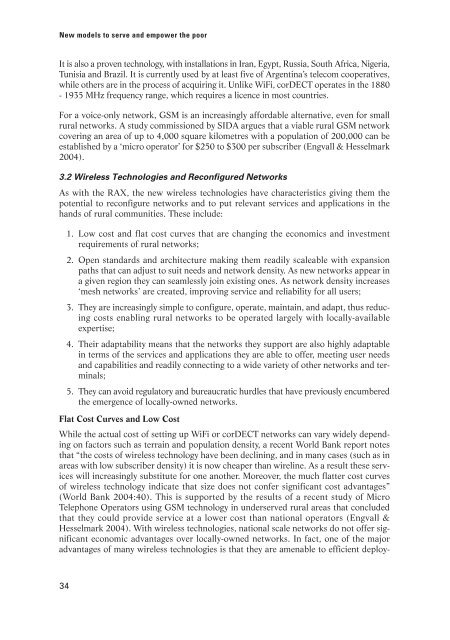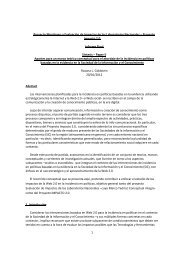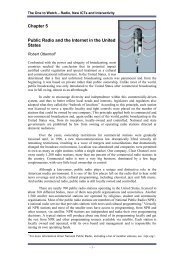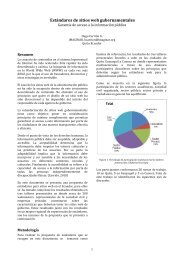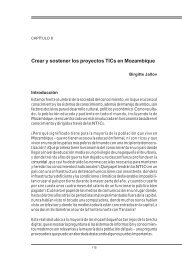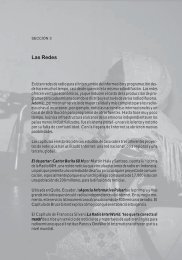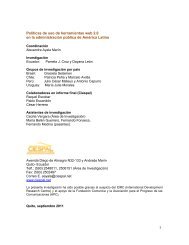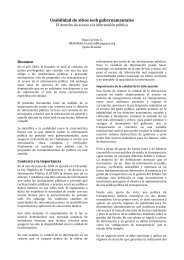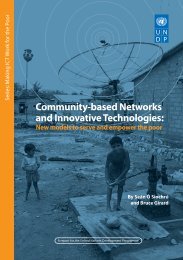Community-based Networks and Innovative Technologies: New ...
Community-based Networks and Innovative Technologies: New ...
Community-based Networks and Innovative Technologies: New ...
You also want an ePaper? Increase the reach of your titles
YUMPU automatically turns print PDFs into web optimized ePapers that Google loves.
<strong>New</strong> models to serve <strong>and</strong> empower the poorIt is also a proven technology, with installations in Iran, Egypt, Russia, South Africa, Nigeria,Tunisia <strong>and</strong> Brazil. It is currently used by at least five of Argentina’s telecom cooperatives,while others are in the process of acquiring it. Unlike WiFi, corDECT operates in the 1880- 1935 MHz frequency range, which requires a licence in most countries.For a voice-only network, GSM is an increasingly affordable alternative, even for smallrural networks. A study commissioned by SIDA argues that a viable rural GSM networkcovering an area of up to 4,000 square kilometres with a population of 200,000 can beestablished by a ‘micro operator’ for $250 to $300 per subscriber (Engvall & Hesselmark2004).3.2 Wireless <strong>Technologies</strong> <strong>and</strong> Reconfigured <strong>Networks</strong>As with the RAX, the new wireless technologies have characteristics giving them thepotential to reconfigure networks <strong>and</strong> to put relevant services <strong>and</strong> applications in theh<strong>and</strong>s of rural communities. These include:1. Low cost <strong>and</strong> flat cost curves that are changing the economics <strong>and</strong> investmentrequirements of rural networks;2. Open st<strong>and</strong>ards <strong>and</strong> architecture making them readily scaleable with expansionpaths that can adjust to suit needs <strong>and</strong> network density. As new networks appear ina given region they can seamlessly join existing ones. As network density increases‘mesh networks’ are created, improving service <strong>and</strong> reliability for all users;3. They are increasingly simple to configure, operate, maintain, <strong>and</strong> adapt, thus reducingcosts enabling rural networks to be operated largely with locally-availableexpertise;4. Their adaptability means that the networks they support are also highly adaptablein terms of the services <strong>and</strong> applications they are able to offer, meeting user needs<strong>and</strong> capabilities <strong>and</strong> readily connecting to a wide variety of other networks <strong>and</strong> terminals;5. They can avoid regulatory <strong>and</strong> bureaucratic hurdles that have previously encumberedthe emergence of locally-owned networks.Flat Cost Curves <strong>and</strong> Low CostWhile the actual cost of setting up WiFi or corDECT networks can vary widely dependingon factors such as terrain <strong>and</strong> population density, a recent World Bank report notesthat “the costs of wireless technology have been declining, <strong>and</strong> in many cases (such as inareas with low subscriber density) it is now cheaper than wireline. As a result these serviceswill increasingly substitute for one another. Moreover, the much flatter cost curvesof wireless technology indicate that size does not confer significant cost advantages”(World Bank 2004:40). This is supported by the results of a recent study of MicroTelephone Operators using GSM technology in underserved rural areas that concludedthat they could provide service at a lower cost than national operators (Engvall &Hesselmark 2004). With wireless technologies, national scale networks do not offer significanteconomic advantages over locally-owned networks. In fact, one of the majoradvantages of many wireless technologies is that they are amenable to efficient deploy-34


